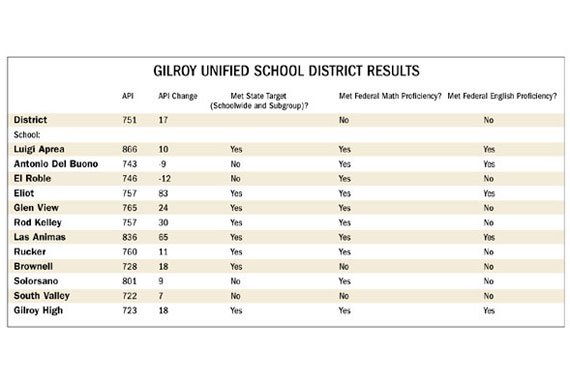The school district has pulled an about-face in a year’s
time.
The Gilroy Unified School District boosted its meager roster of schools meeting state growth targets to eight, up from last year’s one, Las Animas Elementary. However, only five of the district’s 12 schools met federal goals in both English and math, according to data released Thursday by the California Department of Education. Not only did the district’s percentage of schools meeting targets, 67 percent, surpass the state’s 54 percent of target-meeting schools, the district scored 751 on the state index, topping the state average of 742.
“I’ve been psyched for a week,” Superintendent Deborah Flores said. “This is great news for the district.”
Eliot Elementary School’s goal was to grow its score on the Academic Performance Index by six. API measures the scores of students on a scale of 200 to 1,000 in math and English on the May state-administered California Standards Test. Eliot added 83 points to its API score, bringing it to 757. The school showed an unprecedented spike in performance on the state index and met federal criteria – known as Adequate Yearly Progress – a feat they did not manage to accomplish the previous year. AYP requires 35 percent of students across all subgroups to perform at the proficient or advanced level. Although Eliot fell short of the 35 percent, the school moved nearly 11 percent of its students into proficiency on the language arts test, an alternative path to reaching AYP. Eliot also posted the biggest gain in the county, excluding several alternative and continuation schools.
“Is that awesome or what?” said Eliot Principal James Dent.
He attributed his school’s success to various factors including the willingness of the district in allowing Eliot staff to try new tactics, a renewed focus on the basics – reading and mathematics, heightened expectations of the students and various supplemental and intervention programs.
For all its progress, Eliot will remain in it’s second year of Program Improvement status and not advance to year three. One more year of stellar performance will rid Eliot of the dreaded label.
“The students started to realize that if they work hard, they’re going to get some benefit,” he said. “It created a positive snowball effect. For everyone, this is proof that the students can do excellent (work). There’s really no excuse for them not to do well.”
Like Dent, Assistant Superintendent of Educational Services Basha Millhollen credited many factors with the district’s achievement. GUSD welcomed a new superintendent, several new principals and district officials, and Millhollen herself to the district at the beginning of the 2007 school year.
“It was an evolving year,” she said. Pleased with districtwide growth, she said that there is still work to be done, specifically among English language learners and students performing below grade level in reading.
“If I had to target one area,” Flores said, “it’s the English learner population. We have not seen the growth there that we’ve seen districtwide. A major area of focus is initiating a new ELD (English language development) program this year.”
“We have a pretty good idea of where we need to go,” Millhollen added. “Our overarching goals are coherence and alignment across all schools.”
For example, the success at Eliot will set the pace for other schools. Several struggling schools will adopt reading and math intervention materials similar to the ones introduced at Eliot. While reading performance on the AYP index was a mixed bag across school sites, most schools met the federal requirements for math. Brownell Midddle School, which will enter year four of PI, and South Valley Middle School, which will enter year five, were the only two schools that did not meet the 2008 federal math criteria, according to the report.
Another school that made notable progress was Gilroy High. Each of the school’s subgroups added points to its API and made AYP. Administrators received the news days ago but had to remain tight-lipped until Thursday morning.
GHS is working hard to close the so-called achievement gap between white and Hispanic students. Although more than 100 points exists between the two groups on API performance, Hispanic students are rapidly closing the gap, Principal James Maxwell said. At GHS, Hispanic students added 26 points to their API this year, bringing their score to 674. White students added 8, bringing their score to 797.
“Over the last six years, we’ve cut the achievement gap in half,” Maxwell said. “Ten years ago, people saw Gilroy as a low performing district. Now it’s an average to excellent district.”
“What’s most exciting is that none of the schools are under 700,” said Trustee Denise Apuzzo. She pointed out that three of the district’s mainstream schools – Luigi Aprea Elementary, Las Animas Elementary and Ascencion Solorsano Middle – and one of the district’s small schools – the Dr. T.J. Owens Gilroy Early College Academy – topped the 800 mark, joining 36 percent of California schools in meeting the statewide target.
The focus of the current board and superintendent has been to push high academic standards for all students, Apuzzo said.
“You don’t dumb something down because a kid is poor or a minority,” she said, adding that, in the past, “we taught to the lowest common denominator.”
Standards have been raised in the classroom over the last five years, she said, and parents are more aware of the impact of their child’s test scores.
“Reflecting over the last year, it started with the board establishing student achievement goals that are high,” Flores said of the increase in scores.
The biggest change: “We have a really good curriculum,” Apuzzo said. “There’s a complete focus on training, hiring and retaining good teachers.”
Only two schools, Antonio Del Buono Elementary and El Roble Elementary, lost points on the API this year. However, El Roble has been “through a lot of change in a short period of time,” Apuzzo said.
Three different principals have taken the helm at El Roble in as many years, causing an upheaval in leadership, she said. Current Principal Leigh Schwartz came onboard after the 2007/08 school year had already begun. Apuzzo said she’s convinced that this year will be a different story for El Roble, now that the school has implemented several of the programs that were so successful at Eliot.
And the decline in Antonio Del Buono’s scores could be from the huge population shift that took place when many of the school’s high performing students were rezoned to attend Las Animas last fall, Apuzzo said.
“After this year, they’ll be back on track,” she said of the two schools. “I just look at this as a blip.”
Apuzzo was particularly pleased with the results at Brownell. Although the school will enter its fourth year of PI because it didn’t make the federal target, it scored 18 points higher on the API.
“They had a really tumultuous year,” Apuzzo said. “I have to hand it to those teachers who really stuck with it. I’m really proud of Brownell.”














